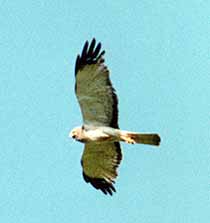
(Circus cyaneus)
Interesting facts:
The male Northern Harrier feeds the female while she is sitting on eggs and for 2 weeks after they hatch. He catches prey, flies home, and calls to the female from the air. She flies up and catches the prey as he drops it to her. She takes it back to the nest, where she rips it apart to feed herself and her young. This method is also used to feed the young when they start flying.
Description:
Male Northern Harriers are pale gray by the age of three. Females are brownish with streaks on the undersides. They are about 16 to 24 inches long and their wingspread is about 42 inches. They have long tails and a white rump.
Habitat:
Northern Harries arrive in Illinois in February or March. Most continue as far north as northern Canada. They appear again on their way south in August, and migrate, singly or by twos, as far south as Central America. A few spend the winter in Illinois, roosting along with short-eared owls in groups.
Those who nest in Illinois find a marsh or a prairie. The male collects grass, sticks, and hay for the female, who builds the large nest. It is up to 18 inches tall if the ground is wet, and from 15 to 30 inches across. The female lays 4 to 6 round white eggs, one every 2 days. She incubates them for about 21-34 days. The young start flying when they are about a month old.
Food:
Each Northern Harrier has a hunting range of 3-40 acres up to one square mile. It hunts in slow flights at a height of 10 to 30 feet, flapping, and gliding over fields. It looks for small mammals, birds, amphibians, and reptiles.
Status:
In Illinois the Northern Harrier is considered endangered because of the destruction of marshland and prairies. The open ground nests are prey to predators like mink and dogs. Adults can live up to seven years.